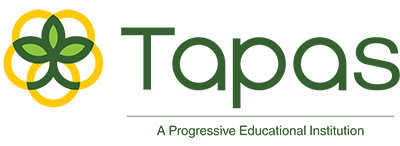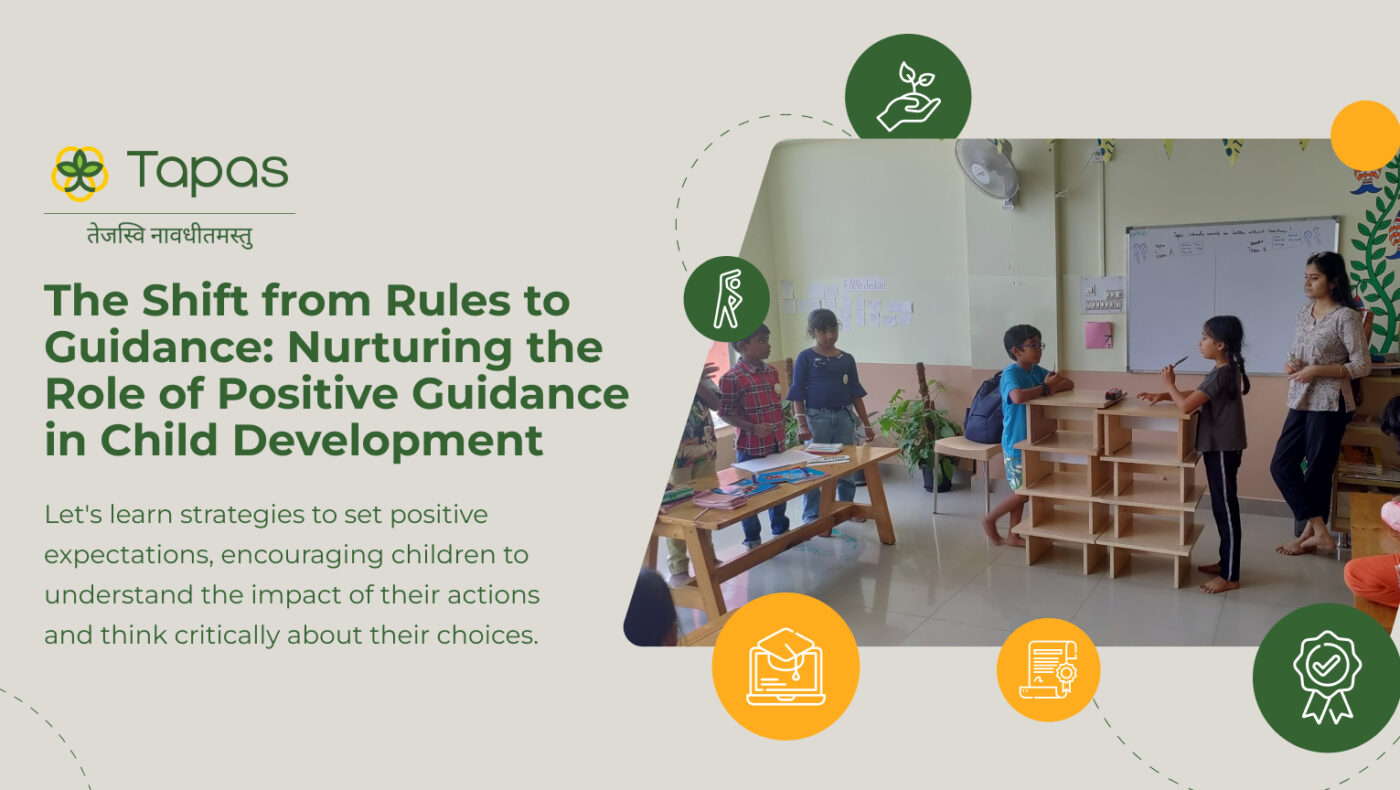Hello, Curious Learners and Educators!
I’m Preethi Vickram, the founder of Tapas Progressive School, and today I want to discuss the significant difference between guidance and traditional discipline in early childhood education.
Our approach at Tapas is founded not just on teaching but on guiding, which nurtures long-term positive behaviors and understanding in our young learners.
Guidance Over Discipline: A Shift Towards Positive Interaction
Let’s think about it this way: shifting from strict rules to a focus on guidelines and positive interactions makes a huge difference. When rules are too rigid, they can dampen a child’s natural curiosity and eagerness to learn. However, guidance is about setting positive expectations and helping children understand the impact of their actions on themselves and others. It encourages them to think and learn, rather than simply telling them what not to do.
For instance, the story shared by Nadia Jaboneta from Pacific Primary demonstrates how young children can resolve conflicts with little adult intervention.
When a dispute arose over a roll of tape in students, instead of dictating who gets the tape, the teacher facilitated a conversation that led to a creative solution by the children themselves.
This scenario exemplifies how guidance can foster self-regulation and empathy among children, crucial skills for their future.
Case Study: Transforming Everyday Challenges
Let me tell you about something real that happened, and it honestly surprised us all.
In an early childhood class, the young learners were having a hard time walking quietly through the halls, which disrupted other classes.
Rather than imposing a strict rule, the educators decided to handle the situation differently.
They called for a class meeting and encouraged the children to brainstorm solutions together. During this meeting, the children came up with some incredibly imaginative ideas.
One suggestion that stood out was to pretend to be “mommy and daddy elephants tiptoeing so as not to wake the babies.”
This simple yet creative idea was a hit!
The children loved the concept and eagerly embraced it. Not only did this approach solve the noise issue, but it also empowered the children, making them active participants in their learning process.
They felt heard and respected, and their sense of responsibility and cooperation grew significantly.
Imagine the possibilities when we encourage our children to come up with their own solutions and actively participate in their learning and growth.
Curious about how to incorporate more guidance into your daily parenting?
I’ve got some tips for you in this blog!
From Rules to Guidelines: A Transformative Approach
Shifting from rules to guidelines can dramatically alter the learning environment from one of restriction to one of empowerment.
Dan Gartrell advocates this approach, focusing on how we use our words. He suggests using positive language to help children grasp the ‘why’ behind what they’re asked to do.
For instance, instead of simply telling children to ‘be quiet,’ which could come across as limiting, why not reframe it? Saying ‘let’s walk quietly so we don’t wake the babies’ makes the action a part of a thoughtful, inclusive game.
This way, children learn to consider the impact of their noise, turning an ordinary rule into a lesson in empathy and cooperation.
As parents, do these things to help your children understand the why behind their actions:
1. Explore the Reasons Together: Whenever you set boundaries or rules, discuss them with your children to help them understand the reasons behind these decisions.
2. Ask Thought-Provoking Questions: Encourage your child to think about the consequences of their actions by asking, “What do you think will happen if we do this?”
3. Lead by Example: Show your child how you make decisions by explaining your own thought processes, emphasizing the ‘why’ behind your actions.
Engaging Parents in Guidance
Parental involvement is absolutely crucial when it comes to guiding our children effectively. You see, when parents and teachers speak the same language of guidance, children receive a consistent message, whether they’re at home or at school which reinforces their learning and behavior.
If you as parents use open-ended questions like, “What do you think will happen if…?” helps maintain an environment of exploration and learning outside the classroom as well.
Building a Community of Kindness
Have you ever noticed that kind individuals often seem to be excellent decision makers?
It’s like their ability to empathize and consider the feelings of others helps them make informed, thoughtful choices.
By fostering acts of kindness and teaching children to recognize the impact of their actions on others, we’re not just teaching them to be nice; we’re nurturing a community spirit that supports their emotional and social growth.
Think of it like this: when children create and distribute kindness signs, they’re not just spreading messages—they’re spreading a culture of positivity and thoughtfulness.
Isn’t that a wonderful way to influence the world around us?
Guidelines Over Rules: Practical Applications
Have you ever thought about what happens when we replace strict rules with flexible guidelines in the classroom? It’s a game changer!
Experts like Dan Gartrell recommend this approach because it helps kids understand why their actions matter and how they affect others.
It’s not about telling them what not to do—it’s about guiding them to make better choices on their own.
Imagine a classroom where kids help set their own guidelines.
They might decide together that walking quietly in the halls keeps the peace, or sharing supplies makes everyone’s day smoother.
Doesn’t that give them a sense of ownership and responsibility? And isn’t it great to see them solving problems together?
What do you think this does for their confidence and their ability to handle bigger challenges in the future?
The Role of Educators in Nurturing Future Leaders
To sum it up, I would conclude that if parents and educators work hand in hand, our kids can indeed have a brilliant future.
As educators, we’re not just imparting academic knowledge; we’re shaping future leaders. By embracing a guidance approach, we tackle immediate behaviors and lay down a robust foundation for future interpersonal skills and leadership qualities.
Our classrooms mirror society, turning every interaction into a valuable learning experience that fosters growth.
Here are some examples on how we can emphasize guidance over strict rule-following:
1. Example of Following a Rule vs. Guidance:
Rule: “Don’t speak out of turn.”
Guidance: “Why do you think it’s important for us to take turns talking?”
Impact: Simply following the rule teaches a child obedience without understanding. However, guiding them to understand the importance of taking turns fosters respect for others’ opinions and promotes effective communication, key leadership traits.
2. Encouraging Question-Asking:
Rule: “Complete your assignments on time.”
Guidance: “What steps will you take to ensure you’re on track with your assignment? Do you need help prioritizing your tasks?”
Impact: Instead of merely enforcing a deadline, engaging in a conversation about planning and resource management helps develop organizational skills and initiative.
3. Building Conflict Resolution Skills:
Rule: “No fighting.”
Guidance: “What can we do to solve this disagreement? What are some ways we can both get what we need?”
Impact: This approach helps children understand the underlying causes of conflicts and teaches them to negotiate and find mutually beneficial solutions, essential for future leaders.
Conclusion
By shifting our focus from enforcing rules to providing thoughtful guidance, we nurture children who are not just rule followers but thoughtful, considerate leaders who understand the ‘why’ behind their actions and the effects on those around them.
Join us on this transformative journey, where we not only teach but guide, shape, and celebrate every small step our children take towards becoming thoughtful, considerate, and proactive members of society.
Facebook page link- https://www.facebook.com/tapaseducation
Instagram profile link- https://www.instagram.com/tapaseducation/
Email- [email protected]

